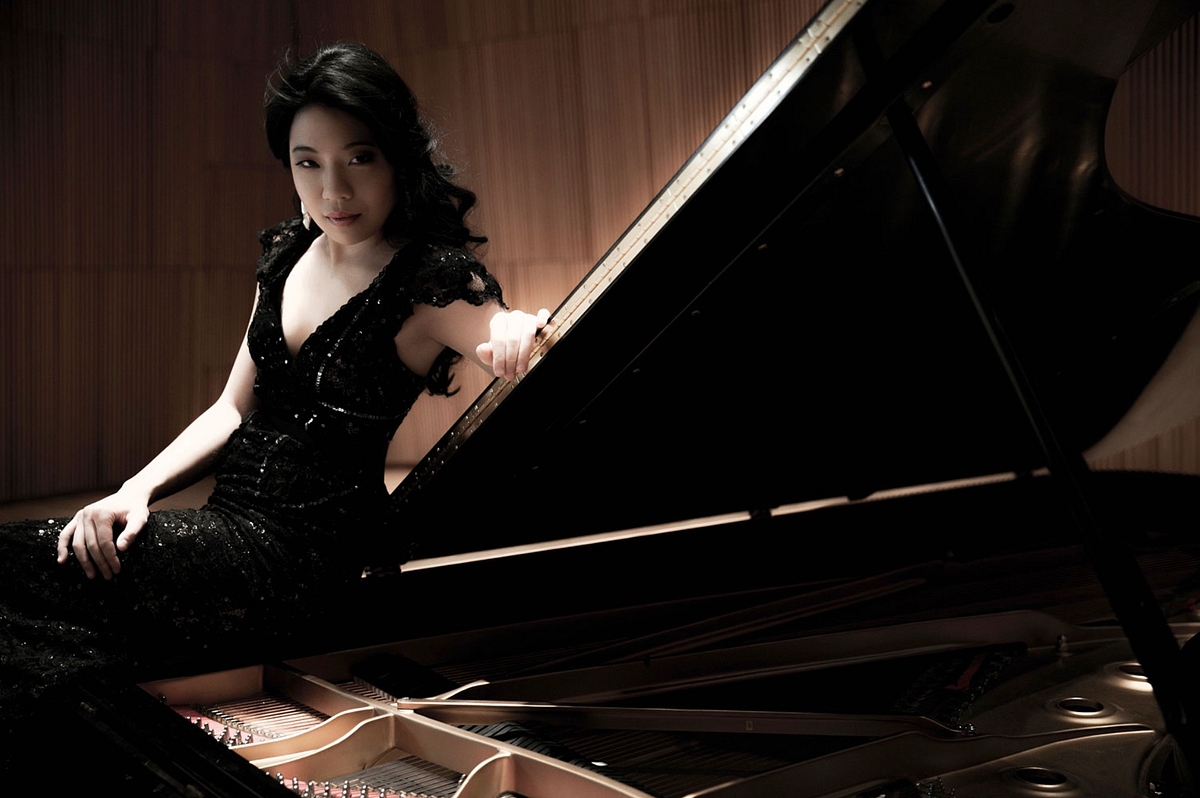
KT Kim Photo
Joyce Yang.
Towering C major chords from organ and orchestra in unison. Dazzling rhythmic interplay between soloist Joyce Yang and the orchestra. An energetic rendition of “The Star-Spangled Banner,” resuming a tradition in Woolsey Hall. Thursday night’s debut of the New Haven Symphony Orchestra’s 2023 – 24 season was full of triumphant moments, even as it very meaningfully kicked off the orchestra’s final season under Music Director Alisdair Neale.
In his remarks to the audience before the program began, NHSO Board President Keith B. Churchwell noted that while the world has changed a lot in the nearly three years since the NHSO’s last concert in Woolsey Hall, the quality and artistry of the orchestra has remained steady. This was evident throughout the last season, even as the orchestra performed under four auditioning guest conductors. (The third candidate, Perry So, was awarded the post, and will begin his tenure with the NHSO in the fall of 2024.)
This quality was evident, too, with the vigor with which the orchestra tackled Anna Clyne’s “Masquerade,” which formally began the program. Audiences heard Clyne’s “Stride” last season, and her language seems well versed in the textural developments of 20th- and 21st-century orchestra music, while still very tied to identifiable fragments of rhythm and melody.
The piece gave the strings a thorough workout, beginning with swirling upward motion before a woozy melody came through, assisted by the high winds, offering the sense of an inebriated waltz. Clyne occasionally employed melodic fragments that drew on film soundtrack-like cliches, but then would subvert this momentum by shifting the key center in mid-phrase. The effect was quite dazzling, especially as the orchestra seemed to fight itself to maintain a dance rhythm — the restless percussion would occasionally add or drop a beat, subverting the momentum with controlled flourishes.
Following this, pianist Joyce Yang took the stage for Tchaikovsky’s Piano Concerto in Bb minor. The program notes indicate that the piece was described as “unplayable” by critics in its time — but with the support of Neale and the NHSO, Yang delivered an electric performance, locking in with breakneck rhythmic precision in rapid fire exchanges with the orchestra, and allowing the piano to breathe as it took a more subdued or accompanying role.
It is important to note that Woolsey Hall at Yale and Lyman Hall at SCSU are acoustically very different spaces. Concerts this season will happen at both. There were moments on Thursday where the natural acoustic of Woolsey obscured some of the more impressive technical work that the piece called for, although the reverberation was favorable in many other instances.
Yang’s ability to deliver a subdued, almost aching melancholy made her a natural fit for Tchaikovsky’s compositional voice, which packs an individual movement full of gorgeous or stirring details. Her accompaniment of melodic statements from cello and oboe in the second movement was sensitive, and as she returned firmly to the forefront for the energetic final movement, the orchestra really made something of the driving, folk-like rhythms that occasionally floated through this movement, delivering something that could in other contexts be identified as “groove.” The momentary pause right after the solo cadenza, before piano and orchestra brought the piece home, was incredibly impactful.

Norman Oates Photo
Gumbs.
The program concluded with Camille Saint-Saëns Symphony No. 3 “Organ Symphony,” with the organist Nathaniel Gumbs. Rather than the concerto format, which positions a clear solo instrument against the group, the symphony here positioned Gumbs as a full fledged section within the orchestra, often serving a harmonically supportive role for other sections or instruments playing melody. Often it was more felt than heard, with sub-bass pipes gently supporting low and middle harmonies in a way that sounded like it was giving a warm hug to the basses and cellos.
Neale mentioned programming this concert to take advantage of the return to Woolsey. Making use of the Newberry Organ in the hall was certainly a clear way to do so. In each of the two movements, the orchestra began on its own, creating a whole world before the organ entered. These moments were especially impactful. The overtone-laden C‑major chord that began the Maestoso section of the final movement was utterly entrancing in such a live acoustic space, even if there were moments where the strings appeared to be vigorously bowing to no avail against the dynamic of the organ. The orchestration allowed for plenty of moments where the sound was pared down, and many of the reed or brass-like stops on the organ were put to good use in combination with wind soloists throughout the work.
In some ways this is a relatively musically conservative start to a season that overall looks to build on the foundation of programming established in previous seasons. We’ll see work again from Joel Thompson and Mason Quinn, as well as work from living composers Reena Esmail and Kevin Puts, alongside canon showings from Mozart, Copland, and Elgar.
But maybe the quality of the musicianship has as much to do with the orchestra’s appeal as their frequent programming of new repertoire. Zack, a former music student who saw the NHSO frequently “about 4 years ago” when visiting friends at the Yale School of Music, felt like he was hearing them “with new ears” attending Thursday’s performance.
“As a student you think ‘oh, it’s some of my professors,’ and that changes your expectations. Today didn’t have that — I was really impressed. For some reason it’s hitting me in a deeper way.”

It must have been a thoroughly exciting concert to start the season! A great variety of works. Sorry to have missed it. It was fun to scroll along with the score to Anna Clyne's piece - it show how much detail and hard work goes into composing for a large orchestra. Adam Matlock's review was one of the most thorough and thoughtful concert reviews I've read in a long time! Well done!